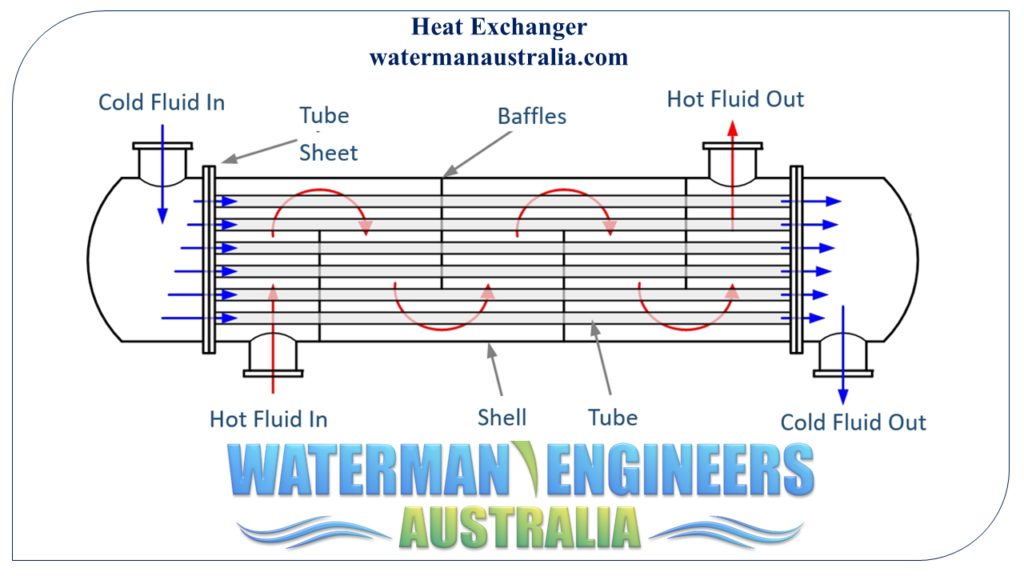
A heat exchanger is a device that allows for the transmission of heat between two different media without any physical contact between them. Heat exchangers work on the idea that thermal energy can be transferred from a hot fluid to a cold fluid. Heat exchangers provide for precise temperature regulation, improving energy efficiency and system functionality by transferring heat between two fluids.
Power plants, chemical plants, HVAC (heating, ventilation, and air conditioning) systems, supermarkets, and many more all employ heat exchangers. They can be found in commonplace home products like air conditioners and water heaters.
In this article, we'll learn about heat exchangers, what they are, how they work, and the different kinds there are. The article also details the common uses and factors to consider when choosing a heat exchanger.
These keywords and phrases were being included by machine and not by the authors. This process is experimental along with the keywords may be updated as the training algorithm increases.
may be the diameter with the cylindrical fins. The corrected fin duration is definitely an approximate, but sensible and precise way of accounting with the reduction in the fin suggestion is to replace the fin size L
Element papers stand for by far the most advanced research with important probable for top impact in the field. A Attribute
“You'll find hardly any supplies and in many cases less fabrication techniques that will manage those pressures and temperatures,” Narayanan claimed.
Heat Exchanger Design and style Manual: A Simple Guidebook for Preparing, Selecting and Designing of Shell and Tube Exchangers will take buyers over a step-by-action manual to the look of heat exchangers in daily follow, demonstrating how to ascertain the successful driving temperature variance for heat transfer. Users will find out how to work out heat transfer coefficients for convective heat transfer, condensing, and evaporating utilizing uncomplicated equations. Dew and bubble details and features are coated, with all calculations� supported with examples. This functional tutorial is meant to assist engineers fix regular problems they could encounter in their day-to-day operate, and will even serve as a valuable reference for college students Mastering about the field.
ASME checks most important-shell and channel-shell junction stresses, which aren't included in TEMA and, typically, govern the tubesheet thickness. Hence, the tubesheet thickness as per ASME is always increased than TEMA. It is actually as a result essential to specify If your tubesheet thickness shall be calculated According to ASME or TEMA.
ASME and TEMA give two other ways of calculating the tubesheet thickness. TEMA’s calculation is much less refined than ASME’s as it doesn't take into account the rigidity furnished by the shell as well as the stationary head.
As being the electrical recent passes through the coils, the air absorbs the heat made. Then, a blower motor distributes the heated air in the ducts and into your living area.
The heat exchanger may be the Main of one's gasoline furnace. By an Trade method, the element generates heat – given that the name suggests. This portion is comprised of the list of steel tubes or coils which are S-formed. These tubes are wrapped all around The within of the heat exchanger.
Tie rods. Tie rods and spacers are utilized to keep the tube bundle jointly and to Identify the shell baffles in the right placement.
, with superscripts “U” and “L” standing for upper limit and reduced Restrict, respectively, amongst which thermal ease and comfort inside of a area is judged suitable.
ten. Flanges. A few kinds of flanges are found in shell and tube exchangers, namely, Girth flanges for your shell and channel barrels; inner flanges from the floating head exchanger to allow disassembly of your internals and removing in the tube bundle; and nozzle flanges in which the flange and gasket benchmarks, the size and force score will likely be set by the road specification. Figure five exhibits three different types of flanges.
In the event the affect aspect exceeds the TEMA boundaries, impingement safety is needed. The TEMA specifications specify different rho-v-2 restrictions for erosive fluids and nonerosive fluids.
Recuperators could be classified according to transfer system in immediate Make contact with and oblique Make contact with kinds. In oblique Make contact with HE, there is a wall (Bodily separation) among the fluids. The recuperators are generally known as a direct transfer type. In contrast, the regenerators are devices through which There exists intermittent heat exchange amongst the hot and cold fluids by way of thermal energy storage and release in the Designing of heat exchanger manufacturer heat exchanger surface area or matrix. Regenerators are mainly classified into rotary and stuck matrix products. The regenerators are called an indirect transfer kind.